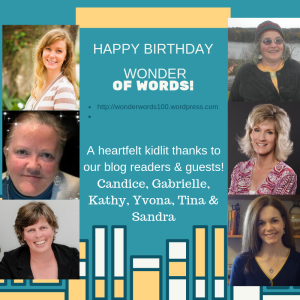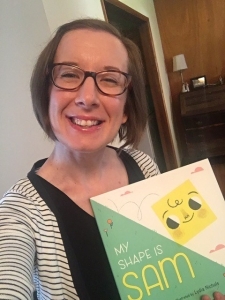
Hi, WONDERers! Have you missed us? We may not be blogging as much lately, but all of us here at Wonder of Words are still reading as many amazing children’s books as we can. For today’s interview on Finding Inspiration, I spoke to Roxanne Troup, author of the newly released picture book, MY GRANDPA, MY TREE, AND ME. Hi, Roxanne. Congrats again on your picture book release! How did you get the inspiration for your story?
Roxanne: A couple years ago, I discovered a new publisher looking for agricultural books, and since I grew up in an agricultural community, I thought it might be a good fit. I set to brainstorming different stories that might work for that publisher and discovered a hole in the market—pecans. I knew a little bit about pecans. They grew wild and in backyards where I grew up, and we harvested them in buckets. But I wondered how the commercial pecan industry worked. Did everyone collect pecans in buckets? So, I started researching. After running across a YouTube video of a farmer harvesting pecans by tractor (from hundreds of trees at a time), I knew I had my topic. I couldn’t get the image of that farmer shaking his trees out of my head—pecans fell like thundering rain!

Candice: I grew up with pecan trees in the backyard and have vivid memories of picking up pecans–the pies my mom would make were definitely worth the effort! What is your favorite part of the creative process? Did you learn anything about your own process while you were working on this book?
Roxanne: That first flush of IDEA is heady and addicting, but then I have to figure out how to make that idea work. And that, is WORK! I don’t know that I discovered anything “new” about my process with this story as it’s not my first (even though it is my debut fiction). But every story—and the way it comes to the page—is different. For this particular story, I had quite a few stop-and-start drafts, meaning I started but never finished them. But each time I started a new draft, I added some important storytelling element or figured out what wasn’t working and tried a new way of fixing it. It wasn’t until my fifth draft that I finally completed the story. (Does that make number five my actual “first draft”?)
Candice: Haha, no way! All that hard work still counts and kudos to you on not giving up! Do you have other creative outlets or hobbies? Do they cross into your writing?
Roxanne: Oooo, that’s a good question. I like lots of creative things: crafting, singing, gardening, interior design. I don’t know that any one of those things crosses over into my writing (though gardening might seem like it with this title), but my favorite part about each is the planning/dreaming stage. And that definitely crosses over. I plan out/dream through many aspects of my stories before I ever sit down to draft—which might explain the whole start-and-stop habit. When I realize something isn’t working according to plan, I stop; and often, don’t start up again until I have puzzled my way through that obstacle.

Candice: Great answer. Do you have any tips you’d like to share about finding creativity?
Roxanne: I think being quiet is a huge creativity booster.
Our brains don’t like being idle, so when we force our bodies to be quiet, our brains fill in that space with all kinds of things—to do lists, conversation replays, dreams for tomorrow, and eventually (if we don’t short-circuit the process by ending our quiet time to do all those things on our list) creative ideas.
Candice: Can you tell us about a future book project you’re working on?
Roxanne: It hasn’t been announced yet, but I do have another informational fiction picture book in the publishing pipeline—this one, about space.

Ooh, space! So exciting! We wish you the best in your writing and publishing journey. Thank you for sharing your tips on creativity and your inspiration for this book.
MY GRANDPA, MY TREE, AND ME (Yeehoo Press) released April 11th. You can find it online at bookshop.org which helps support independent bookstores, and at https://www.roxannetroup.com/pecan.html to also check out fun book activities for your little readers. Request a copy at your local library or indie bookstore.

Author, ghostwriter, and speaker, Roxanne Troup writes kids’ books that celebrate wonder and family. With a background in education, she also writes engaging nonfiction for all ages. She grew up along the waterways of Missouri, surrounded by farmland and legends. Her childhood home, built in the late 1800s, was often visited by members of Jessie James’ gang and full of stories about hidden passageways, underground tunnels, and false floors. In that house, Roxanne learned to read and create her own imaginative stories. Today, she lives in the mountains of Colorado but still loves old houses and history. She is the author of over a dozen books for kids, including My Grandpa, My Tree, and Me. When not writing, Roxanne enjoys hiking with her family, cheering at her kid’s sporting events, and reading a good book. She loves to visit schools to water seeds of literacy and teach about writing. (And sometimes remembers to water the plants in her own garden.)
Illustrator Kendra Binney was raised in a small mountain town with no shoe stores. Most of her time was spent barefoot treading through the minuscule world of spiders, snakes and all things hiding in the grass. Though her paintings have been exhibited, sold, and published around the world, Kendra herself spends most days in a small studio in Portland, OR. There she paints, daydreams, and paints some more.
Call to Creativity: Look at the market specifically to see what isn’t there or underutilized. Read widely and wildly!

















 Lisa Johnston Hancock is an award-winning studio artist, picture book illustrator, and art educator. She enjoys creating work that focuses on environmental education, encouraging a lifelong positive attitude toward the natural world. Lisa recently moved with her husband and two children from sunny Southern Alabama to sunny Southern California.
Lisa Johnston Hancock is an award-winning studio artist, picture book illustrator, and art educator. She enjoys creating work that focuses on environmental education, encouraging a lifelong positive attitude toward the natural world. Lisa recently moved with her husband and two children from sunny Southern Alabama to sunny Southern California.



















